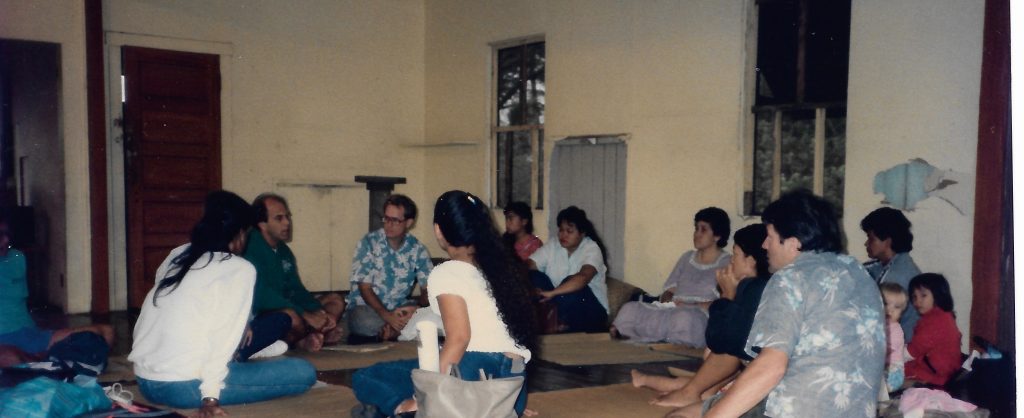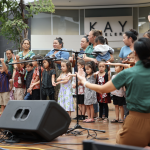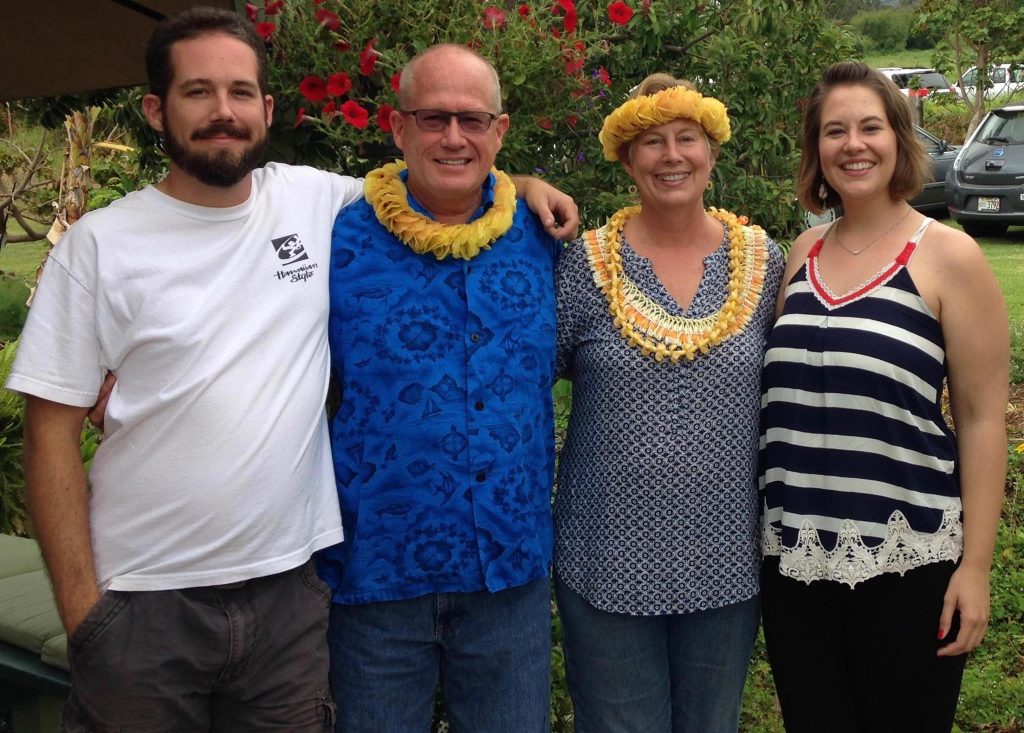Founder describes early days of Hawaiian language immersion program, challenges
Maui Now: A People Of Maui Interview

At the time Native Hawaiian Kiope Raymond was attending the University of Hawaiʻi in the mid-1970s, the educational system was going through significant changes with a move by ethnic groups in Hawaiʻi and other parts of the United States to find a place to tell their stories and contributions to society in college courses.
The Hawaiian Renaissance was in full swing with Native Hawaiians reviving their music and telling their history from their point of view. What became a cornerstone of the Renaissance was the revival of the Hawaiian language — a language no longer used as the official government language in newspapers and Hawaiʻi schools after the overthrow of the Hawaiian monarchy in 1893.
However, A Hawaiʻi Constitutional Amendment in 1978 recognized Hawaiian as an official language, side by side with English, paving the way for the state to support Native Hawaiian language immersion programs.
With a Master’s degree in education, Raymond was hired by the state to create a Hawaiian Studies program at Maui Community College in 1982. In 1986, he was asked to join the board of the ʻAha Pūnana Leo to found the first private, nonprofit pre-school in Hawaiian language on Maui. He founded Pūnana Leo O Maui as a volunteer and not a paid staff.
It is the first formal stepping stone in a Hawaiian language immersion program that can extend from elementary through high school in the D.O.E. to a Ph.D. in Hawaiian at UH Hilo.
There are now three ‘Aha Pūnana Leo schools on Maui — Hāna, Wailuku, and Lahaina — and pathways enabling Hawaiian immersion language students to receive instruction and graduate from Lahainaluna, Hāna, and King Kekaulike high schools. In total statewide, there are 22 Hawaiian language immersion sites in the state Department of Education under the jurisdiction of its superintendent and six charter schools under state Board of Education.
The changes have been profound, and so too is Raymond’s story as he went through his own transformation. Maui Now writer Gary Kubota interviewed Raymond as part of this People of Maui series.
KUBOTA: How was it growing up on Maui?
RAYMOND: I was born in Lahaina in 1954 when Maui’s entire population was less than 40,000. While growing up in Lahaina, most families knew other families in what was, for the most part, a small sugar plantation town. Though he was at first a vocational agricultural teacher at Lahainaluna, my father became a manager in personnel at Pioneer Mill Co. in Lahaina, a subsidiary of American Factors.
KUBOTA: Did you speak Hawaiian at home?
RAYMOND: No, neither parent used Hawaiian as their primary language. They did incorporate Hawaiian, Japanese, Chinese, and Filipino words and phrases into English and Pidgin sentences, much as all local people do. My parents were not fluent speakers of Hawaiian because they were from the second generation of Hawaiian families — ʻohana — born after the American occupation of 1893, a time greatly influenced by the American ideal of Manifest Destiny, including teaching the English language to natives. My parents honored their Hawaiian heritage but, like many others in those days, did not learn, or ponder, that many of their Hawaiian cultural foundations such as the language had been debased.
KUBOTA: How did that affect you?
RAYMOND: When I was young and was asked, “What nationality are you?” I would reply, “I’m Hawaiian, Tahitian, English, Scotch, Irish, and French.” I was confused. Those are my ethnicities. And because the United States does not recognize Hawai’i’s historical sovereignty as a nation, or anyone as a Hawaiian national, the confusion continues for many people. Until the 1893 overthrow of the Hawaiian monarchy, Hawaiʻi was an internationally recognized independent nation.
KUBOTA: How did you acquire your knowledge of the Hawaiian language and Hawaiian history?
RAYMOND: As a manager in personnel, my father and our family were moved to different islands including Kauaʻi and Oʻahu. I learned about the many communities in Hawai’i and their respective socio-political priorities. That helped me to better understand, when I became an adult, the bigger picture regarding the lack of an appropriate Hawaiian Studies curriculum in the Hawaiʻi public education system. That helped me to choose my educational path. My education in formal Hawaiian language started with an ʻohana member, Aunty Birdie Reist, who was 86 when I was a 20 year-old student in a first-year Hawaiian language course at the University of Hawaiʻi at Mānoa. She, other kūpuna, and my various university kumu provided me with my foundation in the language.
KUBOTA: How did you help to start the first Pūnana Leo program on Maui?

RAYMOND: In 1985 my wife, Lisa Schattenburg-Raymond, and I had our first keiki, Kuaola. The ʻAha Pūnana Leo, comprised of colleagues and friends who knew about my son and therefore my vested interest in Hawaiian language revitalization, approached me. In 1986, I was asked to join the ʻAPL board and to organize the creation of a Maui Pūnana Leo. In 1987, the Pūnana Leo O Maui opened.
KUBOTA: What were some of the challenges?
RAYMOND: In the mid-80s, the pre-school licensing process was overseen by officials with the state Department of Health and Human Services. They were very helpful to me. However, finding a suitable place to operate the pre-school was as difficult then, I think, as it is today. But, sometimes good things happen by word of mouth and who you know.
Our lack of a suitable space came to the attention of members of the congregation of the Wailuku Baptist Church, especially Walter Hoʻopiʻi and his wife Rose and Taka Harada, among others. With their support, the Pūnana Leo O Maui leased church space from them and began there.
In addition, there were many in the Maui community, like the members of the Maui Young Democrats, who realized the rightness of revitalizing the Hawaiian language and helped in many ways. I have boundless mahalo to the first teachers I hired — Kealiʻi Reichel, Kekuhi Kanahele Santiago and Kanani Bright. They were very courageous because they were going to work in a school taught entirely through the medium of Hawaiian; something that had not existed on Maui in nearly a hundred years. And, there were no native speakers of Hawaiian under the age of 30 on Maui at that time.
KUBOTA: I understand you also used kūpuna who were native speakers to help?
RAYMOND: Yes, many Maui kūpuna did kōkua those three young kumu with great aloha and commitment. I still have a list of nearly 60 Maui kūpuna who, in some way either great or small, supported the Pūnana Leo and Hawaiian language revitalization. Sadly, they have now all passed.
KUBOTA: Can you give me examples of how kūpuna native speakers helped in the early days of Pūnana Leo?
RAYMOND: As native speakers, the kūpuna were role models for the use of Hawaiian. With the kumu, they helped the keiki develop communication, social, physical, problem-solving and creative skills. But important too were their interactions in Hawaiian with the parents. They were exemplars for the parents regarding what could be accomplished in their own homes. The ʻohana members were also embarking on a unique journey. I sincerely mahalo those first parents, and I will always mahalo any parent that has ever enrolled their keiki in the program.

KUBOTA: I know when I was growing up, there seemed to be a tracking system in public schools depending on the ethnicity. What has been the impact of Hawaiian immersion schools?
RAYMOND: The immersion program has helped in a reclamation of cultural sovereignty and helped foster the emergence of socio-political sovereignty as well. More and more as their numbers grow, Hawaiian language immersion graduates are seeking and obtaining degrees in higher education. Fields include medicine, law, art, literature, education, journalism, agriculture, aquaculture, and many more. Those examples are all disciplines Hawaiians engaged in in the 1800s, when the Hawaiian language was the medium for everyone in Hawaiʻi. It’s had a positive effect on my family personally.
KUBOTA: In what way?
RAYMOND: Both my son Kuaola and daughter Kaleʻa are graduates of Hawaiian immersion programs. My son has a degree in geology and is a Haleakalā National Park ranger. His knowledge in geology and Hawaiian studies is helping him certainly. My daughter has a degree in theater costume construction and has started her own business, Laʻahana Creations. She uses her own, traditionally-made, kapa to make earrings and other, wearable, kapa items. She has to research the Hawaiian stories to better interpret Hawaiʻi’s designs and motifs into her creations.

KUBOTA: Was there a turning point in your work where you knew things would take off?
RAYMOND: Respecfully, I would characterize what is happening as a revitalization of inter-generational language transmission. The ultimate goal is to have language transmission from makua to keiki and then to the keiki of those keiki, which then makes the makua the kupuna transmitting to their moʻopuna. That is beginning to happen among more and more of the ʻohana. Happily too, we are also seeing older siblings teaching younger siblings — an intra-generational transmission. So, if one thinks of language revitalization work in those terms, it is not something that “takes off”. And, it is not about any individual. It is an aukahi, a movement of unity and a focus on the ʻAPL vision statement: E Ola Ka ʻŌlelo Hawaiʻi – The Hawaiian Language Shall Live.
KUBOTA: Did you ever imagine it would grow the way it has?
RAYMOND: Yes! Revitalization means to reclaim a vitality, a strong and active energy. Throughout Oceania, the term kainga — ʻāina — can mean family or land; or both! When we strengthen aspects of our ʻāina, including our ʻōlelo, our language, then our vitality endures and grows. This year, the Pūnana Leo O Maui celebrates its 36th year. One of the first parents in the program and Pūnana Leo O Maui’s first director, Hōkūlani Holt, remains a steadfast supporter. Kili Namauʻu, the current director, was just honored for her 30 years of leadership and commitment.
KUBOTA: What about yourself? What lies ahead?
RAYMOND: I’ll continue to serve on the ʻAha Pūnana Leo board and support Hawaiian language revitalization. Since the beginning of the movement, we have all had to “envision” a future with a living Hawaiian language. I have always been inspired by, and paraphrase for myself, the Dr. Martin Luther King, Jr. speech: “I have seen the promised land. I may not get there with you but we, as a people, will get there.”









